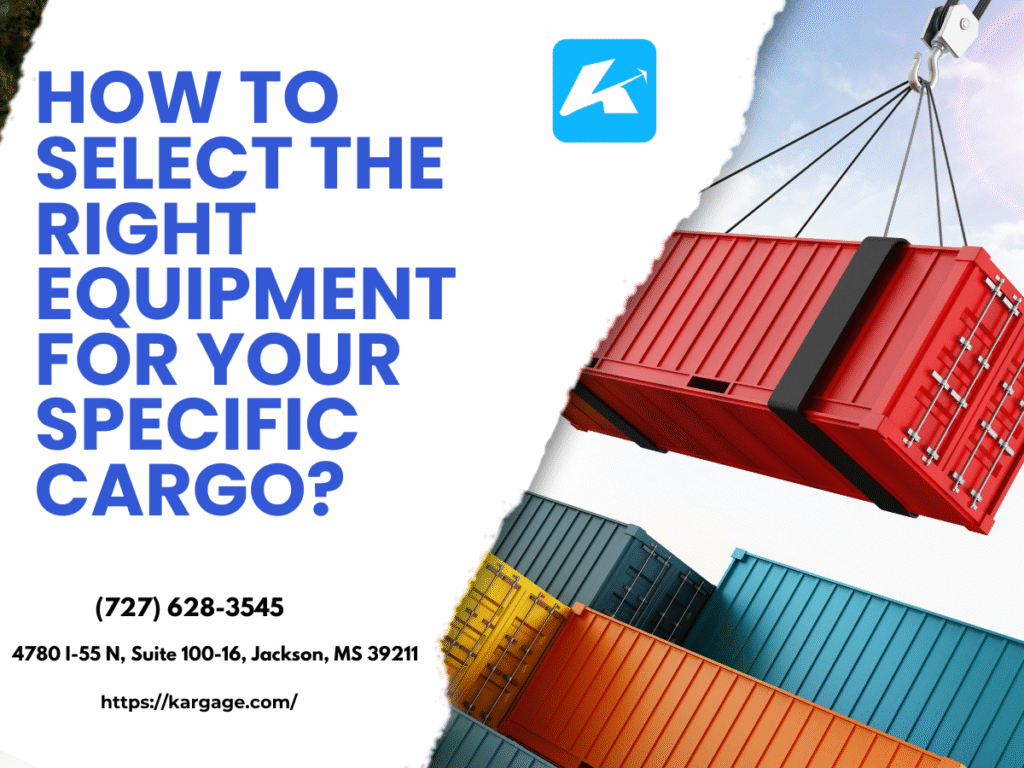Shipping cargo is a bit like packing for a trip—you need the right gear to get the job done safely and efficiently. Whether you’re moving fragile electronics, oversized machinery, or perishable foods, choosing the right equipment for your freight is crucial to avoid damage, delays, or extra costs.

With so many options, from dry vans to reefers, how do you pick the perfect fit?
This guide shares five key strategies to help shippers select the right equipment for their cargo, ensuring smooth and secure transport.
1. Understand Your Cargo’s Requirements
Every cargo has unique needs based on its size, weight, and sensitivity. Start by assessing your freight’s specifics: Is it temperature-sensitive, like frozen seafood? Oversized, like construction equipment? Fragile, like glassware?
For example, perishables need refrigerated trailers (reefers) to maintain specific temperatures, while heavy machinery might require a flatbed with secure tie-downs. Knowing your cargo’s dimensions, weight limits, and handling needs sets the foundation for choosing the right equipment.
Pro Tip: Create a cargo profile listing weight, dimensions, temperature needs, and handling instructions to guide your equipment choice.
2. Match Equipment to Cargo Type
Different cargo types call for different equipment. Here’s a quick rundown of common options:
- Dry Van: Ideal for standard, non-perishable goods like boxed products or clothing.
- Reefer (Refrigerated): Perfect for temperature-sensitive items like produce, pharmaceuticals, or frozen foods.
- Flatbed: Suited for oversized or heavy loads, like machinery or construction materials, that don’t need enclosure.
- Step Deck/Drop Deck: Great for tall cargo that exceeds standard height limits but isn’t too heavy.
- Lowboy: Best for extremely heavy or oversized equipment, like bulldozers, with low clearance for bridges.
Mismatching equipment—like using a dry van for frozen goods—can ruin your cargo.
Action Step: List your cargo’s type and match it to the equipment options above. Consult your carrier or broker for specialized needs.
3. Consider Load Size and LTL vs. FTL
Your cargo’s size determines whether you need Less-Than-Truckload (LTL) or Full Truckload (FTL) equipment. LTL is cost-effective for smaller shipments sharing space with other freight, but it requires sturdy packaging to handle multiple stops. FTL is better for large or sensitive cargo that fills a trailer, reducing handling risks.
For example, a few pallets of chilled vaccines might go LTL in a reefer, while a full load of lumber needs an FTL flatbed. Choosing the right load type ensures efficiency and safety.
Kargage, based in Jackson, Mississippi, helps shippers pick the right equipment for LTL or FTL, tapping into their network of over 31,000 carriers.
Quick Tip: Calculate your cargo’s volume (length x width x height) and weight. Compare LTL and FTL costs to find the best fit.
4. Verify Carrier Capabilities and Compliance
Not all carriers have the equipment or expertise for your cargo. A reefer carrier, for instance, needs reliable temperature controls and monitoring systems for perishables. Flatbed carriers must have proper securing gear, like chains or tarps, for oversized loads.
Check the carrier’s track record with your cargo type. Do they comply with regulations, like the FDA’s Food Safety Modernization Act for food or DOT rules for heavy loads? Ask about equipment maintenance and backup systems to avoid breakdowns.
Best Practice: Request the carrier’s equipment specs and compliance records. Ensure they meet standards for your cargo, like temperature logs for reefers.
5. Plan for Protection and Insurance
The right equipment isn’t just about transport—it’s about protection. Ensure the equipment safeguards your cargo from damage, weather, or theft. For instance, reefers need sealed doors to maintain temperature, while flatbeds require weatherproof tarps for exposed loads.
Cargo insurance is also key. Standard carrier liability may not cover full losses, especially for high-value or temperature-sensitive goods. Confirm the carrier’s insurance and consider additional coverage for peace of mind.

Kargage works with shippers to pair cargo with equipment and carriers that prioritize protection and compliance.
How to Start: Discuss equipment and insurance options with your carrier or broker. Verify that the trailer type matches your cargo’s protection needs.
Putting It All Together
Selecting the right equipment for your cargo is the key to safe, efficient shipping. By understanding your cargo’s needs, matching it to the right equipment, choosing LTL or FTL, verifying carrier capabilities, and planning for protection, you’ll set your freight up for success.
These steps aren’t just about avoiding headaches—they’re about delivering quality to your customers. At Kargage, we’ve seen how the right equipment choice keeps shipments on track for our clients. But this isn’t about us—it’s about you.
Ready to move your cargo? Call us at (727) 628-3545 for a quote. With these strategies, you’re equipped to ship smarter and safer.

